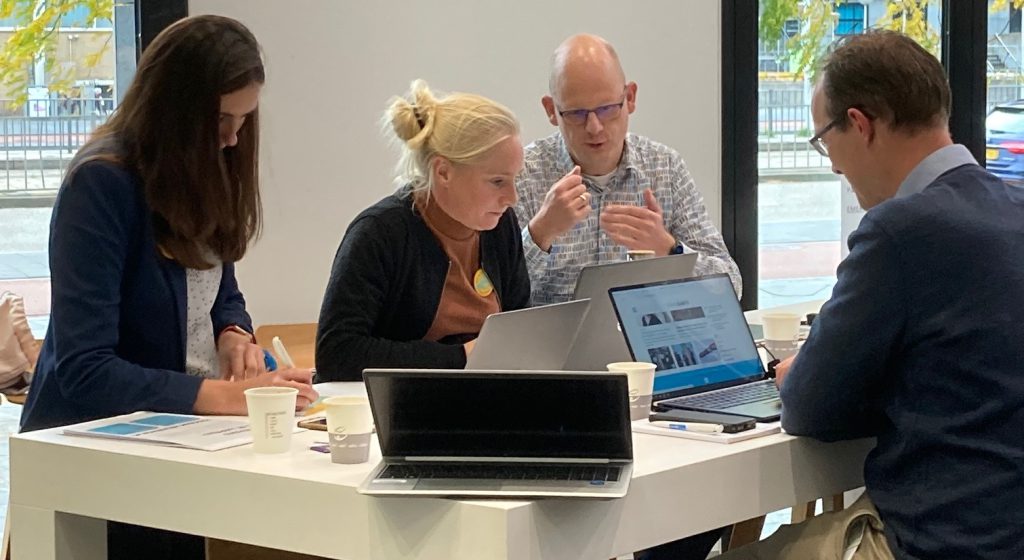Diederik Kuster of the department of Physiology at Amsterdam UMC is researching what causes heart muscle to become thickened and increase in size. He has been doing that by putting mice on an unhealthy diet and then observing how their hearts develop. And yet that ought to be possible with fewer lab animals was his thinking.
That’s why he registered for the Helpathon; an event organised every year for the past three years by the TPI Helpathon team. This year’s participants included Sue Gibbs, professor of molecular cell biology and immunology at Amsterdam UMC and pioneer in the area of animal-free research. Around thirty volunteers with expertise in a wide range of scientific fields put their heads together online and offline to come up with answers to how research can make do with less animal testing.
Transition agency ‘Meneer de Leeuw’ facilitated the Helpathon, providing organisation and presentation.
Former athletes with thickened heart muscle
Thickening of heart muscle — hypertrophic cardiomyopathy — is caused by a combination of genetic and environmental factors. It often occurs in combination with obesity. The current method of treatment simply focuses on treating symptoms: patients are given drugs to reduce their heartbeat and help the heart function better, but it is not currently possible to stop or reverse the thickening.
Top athletes also often have bigger hearts. But luckily, that doesn’t usually cause them any problems. For the vast majority of former athletes, their hearts decrease in size when they become less active in their sport. But not all of them. The Argentinian footballer Diego Maradona, who died last year of a heart attack, was a good example of this disease.
The volunteers helping Kuster find an answer to his problem came up with a variety of solutions, perhaps the most interesting being to focus your research on the Maradonas of this world. Try to find databases documenting former athletes with increased heart size. And see if you can find out with data-based research under what conditions the group with a hereditary predisposition to increased heart size develops this disease, and what the differences are between those who suffer from this hypertrophy and those who do not.
Chip with blood vessels
Another researcher who wants to see whether his research can be conducted with fewer or completely without lab animals is internist Rick Meijer of Radboud University Medical Centre, Nijmegen. He studies the tiny blood vessels that are present in all bodily tissue. In healthy people, these blood vessels dilate under the influence of insulin to allow more blood and nutrients to get through. But in people with type 2 diabetes, this dilation often no longer functions well. In our bodies, the chemical isovaleric acid plays a crucial role in vascular dilation. Meijer wants to study whether it helps to reduce the amount of isovaleric acid in the diet of mice who have been fed a diet with a high fat content. The next step is to see whether this would also be the same in humans. And his question was thus whether the step testing animals could be replaced with animal-free research.
Reverse your research cycle!
The Helpathon experts pondered how this question might be answered. One of the solutions they came up with: use a chip containing little blood vessels, muscle, liver and/or intestinal cells, which would let you find out more precisely how isovaleric acid actually affects a blood vessel.
Another solution they thought up: reverse the research cycle — start with patient data, use it to see whether you can discover differences in the way isovaleric acid functions, and whether you can find an explanation for these differences in genes or environmental factors.
Both researchers were also invited to become members of the hDMT consortium (human Disease Model Technologies), a network of experts who research disease using computer models and therefore avoid animal testing.
Not a competition
Kuster and Meijer were both pleasantly surprised by the cooperative atmosphere of the Helpathon. “There’s a lot of competition in scientific research. I didn’t see it here at all”, Kuster said. “It’s nice to have a chance to think about your research along with a group of other people.”
Meijer: “It’s interesting how these people see my research questions from different perspectives.”
Both will certainly be incorporating the ideas suggested into their research. Will they be able to do away with animal testing completely? “That’s our goal, but alternative models can’t yet simulate all the complexities of a living organism”, Meijer believes. He does think that the solutions put forward by the Helpathon will help him to use fewer lab animals at certain stages of his study.
